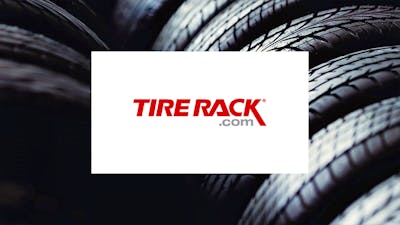Best Tires for SUVs
Which are the best tires for your dependable SUV? The answer depends on many factors. The manufacturer’s priorities when they decided on tires for your SUV may be different than yours. You may place a high value on things like fuel economy and a smooth ride or maybe you’re more focused on winter weather capability. Whatever your priority, the good news is that there are multiple tire options for you to choose from.
Get the Best Deals on Tires
Car Talk recently launched our Golden Wrench Awards for excellence in tires. Below are our overall picks for the top tires for your SUV or crossover.
Golden Wrench Awards Winners for Best SUV/Crossover Tire
Car Talk's methodology
All of these tire picks were ranked using Car Talk's unique methodology based on over 30 different data points:
Consumer Satisfaction: Consumers provided data about what their experience was using tire models within each of these brands.
Industry Professionals: Car Talk researchers performed a nation-wide survey of over 800 mechanics and industry professionals for their opinions.
Government Reporting: Statistics reported for safety and durability.
Tire Quality and Engineering: A tire brand’s overall quality and engineering or innovation influenced a consumer’s decision to purchase.
Performance: Car Talk looked at how tires from these particular brands performed in a variety of weather conditions.
Our Own Testing: While we cannot test every tire on the market, we can test the most popular and highly rated models to see if they live up to the hype. If we have tested a tire in our rankings, we point that out.
Best Tires for SUV/Crossover
Continental CrossContact LX25
The CrossContact LX25 from Continental is our Golden Wrench winner due to its truly all-season capabilities, excellent handling and traction in dry, wet and lightly snowy conditions, and its solid reviews and ratings.
- Excellent reviews and ratings
- Superior all-season capabilities
- Available sizes: 16” - 22
Michelin CrossClimate SUV
The CrossClimate SUV receives the Golden Wrench due to its excellence in handling, traction and tread life in every season. The CrossClimate has an innovative tread pattern which allows for stellar grip and stability in all seasons. This tire earns the U.S. Tire Manufacturers Association’s (USTMA) three peak mountain snowflake symbol denoting its approval for severe snow duty. In our testing, the CrossClimate2 performed well in all weather and had none of the compromises of a dedicated winter tire.
- Superior, innovative tread pattern
- Excellent reviews and ratings
- Available sizes: 16” - 20”
Cooper Discoverer SRX
The Discoverer SRX from Cooper Tires receives our Golden Wrench award due to its excellent performance in all seasons and highly rated customer reviews.
- Solid reviews and ratings
- Long tread life
- Available sizes: 16” - 22”
Pirelli Scorpion Verde All Season Plus 2
The Scorpion Verde All Season Plus 2 from Pirelli is our Silver Wrench winner, due to its innovative design, true all season capabilities and long tread life.
- Environmentally conscious technology
- Great all season performance
- Available sizes: 16” - 22”
Falken WildPeak A/T Trail
Falken’s WildPeak series is quickly taking over as the aftermarket choice for those who want better off-pavement capability, but without the burden of poor fuel economy, poor on-pavement performance, and short treadlife. Like the CrossClimate2, this tire earns the three peak mountain snowflake symbol denoting its applicability to severe snow duty. During our off-pavement and winter testing, this tire impressed us.
- Excellent performance
- Great fuel economy
- Available sizes: 16” - 20”
Falken ZIEX CT60 A/S
This all-season ZIEX CT60 A/S from Falken was designed specifically for CUVs and SUVs. New to the market, its early reviews are all trending positive. In our testing it offered a quiet ride and secure wet-weather traction on a midsize SUV. It is also a very affordable tire.
- Great consumer reviews
- Designed specifically for CUVs and SUVs
- Available sizes: 16” - 20”
BFGoodrich Advantage TA Sport LT
The Advantage TA Sport LT from BFGoodrich is our Silver Wrench winner due to its long tread life, excellence in snow and severe conditions and sturdy handling in all four seasons.
- Great reviews and ratings
- Solid handling and grip
- Available sizes: 15” - 22”
Goodyear Assurance CS Fuel Max
The Goodyear Assurance CS Fuel Max receives our Bronze Wrench as this tire offers solid durability, dry, wet, and snow capabilities. Its low rolling resistance design enhances its fuel economy.
- Good fuel economy
- Reliable and durable
- Available sizes: 17” - 18”
Honorable mentions and writer's picks by size
There are also a lot of choices when it comes to SUVs. There are small SUVs such as the Ford Escape, Toyota RAV4, Honda CR-V, and Jeep Cherokee. Then there are midsize SUVs including the Hyundai Santa Fe, Kia Sorento, Volkswagen Atlas, and Honda Pilot. Sitting at the top of the heap are large SUVs such as the Ford Expedition, Chevrolet Tahoe, and Nissan Armada.
That’s a wide range of potential tire sizes for a wide range of vehicles. Here are our honorable mentions and writer's personal favorites for tires for your SUV depending on which SUV you park in your driveway.
Small SUVs
Best 17-inch Tires for Small SUVs (Includes Ford Escape)
- Kumho Crugen HT51 - Best budget tire
- Falken ZIEX CT60 A/S - Best mid-priced tire
- Yokohama Geolandar G91AV - Best superior tire
Best 18-inch Tires for Small SUVs (Includes Honda CR-V)
- Kumho Crugen HT51 - Best budget tire
- Falken ZIEX CT60 A/S - Best mid-priced tire
- Michelin Latitude Tour HP - Best superior tire
Best 19-inch Tires for Small SUVs (Includes Toyota RAV4)
- Kumho Crugen HT51 - Best budget tire
- Falken ZIEX CT60 A/S - Best mid-priced tire
- Goodyear Eagle LS-2 - Best superior tire
Midsize SUVs
Best 18-inch Tires for Midsize SUVs (Includes Honda Pilot)
- Kumho Crugen HT51 - Best budget tire
- Falken ZIEX CT60 A/S - Best mid-priced tire
- Michelin Latitude Tour HP - Best superior tire
Best 19-inch Tires for Midsize SUVs (Includes Kia Sorento)
- Kumho Crugen HT51 - Best budget tire
- Falken ZIEX CT60 A/S - Best mid-priced tire
- Michelin Latitude Tour HP - Best superior tire
Best 20-inch Tires for Midsize SUVs (Includes Volkswagen Atlas)
- Kumho Crugen HT51 - Best budget tire
- Falken ZIEX CT60 A/S - Best mid-priced tire
- Michelin Pilot Sport 4 SUV - Best superior tire
Best 21-inch Tires for Midsize SUVs (Includes Ford Explorer)
- Yokohama Geolandar X-CV - Best budget tire
- Continental CrossContact LX Sport - Best mid-priced tire
- Michelin Pilot Sport 4 SUV - Best superior tire
Large SUVs
Best 18-inch Tires for Large SUVs (Includes Toyota Sequoia)
- Kumho Crugen HT51 - Best budget tire
- Continental TerrainContact H/T - Best mid-priced tire
- Michelin LTX A/S - Best superior tire
Best 20-inch Tires for Large SUVs (Includes Nissan Armada)
- Laufenn X Fit HT - Best budget tire
- Firestone Destination A/T2 - Best mid-priced tire
- Cooper Discoverer AT3 XLT - Best superior tire
Best 22-inch Tires for Large SUVs (Includes Chevrolet Tahoe)
- Kumho Crugen HP71 - Best budget tire
- Bridgestone Dueler H/L Alenza Plus - Best mid-priced tire
- Continental PremiumContact 6 - Best superior tire
Original equipment SUV tires
There are a wide range of tire sizes for SUVs that not only vary from one SUV to the next, but even within the trim range of a single SUV depending on which one you buy. The key is getting a tire that fits the wheel you have on your vehicle, so start by determining the size of your wheels and then research the best tires in that size. Always check with your retailer that the tire you selected has the correct specs to match your specific vehicle.
Top replacement tire brands for SUVs
We’ve recommended three replacement tires in a variety of sizes, with moderately priced and cost-no-object varieties. No matter your budget, there are plenty of choices available for your SUV. All of these tires have ratings of four-stars or higher based on consumer surveys and all are based on the 2023 model year:
17-inch Tires for SUVs
- Budget: Kumho Crugen HT51 - This tire is an all-season grand tourer that offers good handling, a smooth ride, and year round traction. Prices are generally less than competitors’ offerings.
- Moderately Priced: Falken ZIEX CT60 A/S - This tire is moderately priced and designed specifically for crossovers and SUVs. In our testing it performed well in all weather offering a smooth ride, confident handling, and good wet-weather traction.
- Cost-No-Object: Michelin Latitude Sport 3 - The Latitude Sport 3 is a more expensive proposition, but gets high marks for performance in wet or dry conditions.
18-inch Tires for SUVs
- Budget: Kumho Crugen HP71 - Affordably priced, this all-season does best in dry weather and offers high ratings for comfort.
- Moderately Priced: Falken ZIEX CT60 A/S - This tire offers long tread life, all-season capability, and a smooth ride designed specifically for crossovers and SUVs.
- Cost-No-Object: Michelin Primacy MXM4 - You will pay a premium for this tire, but you're getting a tire highly rated for comfort, and both wet and dry performance.
19-inch Tires for SUVs
- Budget: Kumho Crugen HP71 - Affordably priced, this reasonable all-season tire performs well in dry weather and offers high ratings for comfort.
- Moderately Priced: Falken ZIEX CT60 A/S - This tire balances comfort with good performance in wet and dry conditions.
- Cost-No-Object: Michelin Latitude Sport 3 - The Latitude Sport 3 gets high ratings for its performance in both wet and dry conditions.
20-inch Tires for SUVs
- Budget: Kumho Crugen HP71 - This reasonably priced all-season tire performs well in dry weather and offers high ratings for comfort.
- Moderately Priced: Goodyear Assurance WeatherReady - This is a solid performer with high marks for snow, wet, and dry conditions, good treadwear performance, and a comfortable ride.
- Cost-No-Object: Goodyear Eagle Sport All-Season - Solid performance in all types of weather and a comfortable ride are why this might be the right option for you.
21-inch Tires for SUVs
- Budget: Bridgestone Dueler H/L Alenza Plus - The Dueler gives you long treadlife, smooth ride, and year-round traction.
- Moderately Priced: Vredestein Quatrac Pro - These receive high marks from consumers in all weather along with high ratings for comfort, treadwear and are on our list for testing in 2024.
- Cost-No-Object: Pirelli Scorpion Verde All Season - This all-season offering from Pirelli gets high marks for wet and dry performance and helps optimize fuel efficiency.
22-inch Tires for SUVs
- Budget: Kumho Crugen HP71 - Affordably priced at $186 per tire, this all-season does best in dry weather and offers high ratings for comfort.
- Moderately Priced: Bridgestone Blizzak DM-V2 - Rated for severe ice and snow, the winter compound Blizzak earns high ratings in all winter weather conditions.
- Cost-No-Object: Pirelli Scorpion Winter - The Scorpion Winter from Pirelli is a winter tire with a high price, but receives top marks across the board for wet, dry, and snow performance.
When should you replace tires?
There are two regular milestones that will suggest that it’s time to replace the tires, not only on your SUV, but any vehicle: Time and mileage.
One little-mentioned truth about tires is that tire manufacturers make OEM-specific tires for the automakers. These “OEM” tires don’t have the same treadlife that the tire model does when you buy it as a replacement tire. The replacement tires come with more treadlife. Considering most drivers cover between 12,000 and 15,000 miles per year, the vast majority of SUV owners are going to be past the mileage that their original equipment tires were intended to cover before they’ll go past the tire’s usable age.
The life of your tire can be somewhat predicted by its UTQG (Uniform Tire Quality Grade) rating. Tire manufacturers apply their own grades to tires for treadwear, traction and temperature. When you’re researching tires online, a UTQG will come up next to the tire name in three digits and a number (ex. 500 A A).
You can glean a bit of info from the tires by reading this rating:
- 500 - The durability rating of a tire, compared to a control tire with a treadlife of 100. To obtain a grade, tires run on a 640 kilometer course for 11,520 km. Every 1,280 km, the tread depth is measured, to provide a projected tread life. The higher the number, the longer the predicted treadlife.
- A - This is the Traction rating of a tire, which indicates how well a tire stops in wet conditions. The highest letter grade is AA, followed by A, B and C.
- A - The second letter in the UTQG is the Temperature rating, which indicates how well a tire holds up to extreme heat. A is the highest, followed by B and C.
The other consideration is time. Each tire has a raised date code on the sidewall. The number begins with the letters “DOT” followed by 12 digits in three four-digit groups. The date code is the third group of four digits. To decipher the date of your tires, the first two digits represent the WEEK the tire was produced, and the second two digits represent the YEAR.
For example, if your tire’s date code is 3217, that indicates the tire was manufactured in the 37th week of 2017, or some time between September 11 and 17th that year.
Once tires go beyond five years old, it’s time to consider replacing them. Tires are made up not just of rubber and steel or kevlar belts, but chemicals that help the tires resist UV rays, temperature changes and a lot of other environmental hazards. Those chemicals start to break down after five years or so, and the tires aren’t doing the job that they need to do.
Why not replace with original equipment tires?
There’s no harm in replacing your tires with the shoes it came with from the factory. However, depending on what kind of driver you are, there are significant reasons to purchase something different. Many vehicle owners are unhappy with the compromises that manufacturers make when choosing original equipment tires.
You only need to purchase ONE set of tires for your car every four years or so, depending on how much you drive. When an auto manufacturer purchases tires, they buy them by the hundreds of thousands. For the manufacturer, the decision to choose a supplier of one brand or another comes down to a price point.
Consider how you will be driving your SUV. Are you sticking with highway miles for the daily commute? Are you focused on having an SUV that won’t get stuck when winter does its worst? Are you all about heading off-road? Pick replacement tires best suited to the kind of driving you plan to do in your SUV.
Changing SUV tire sizes
Depending on the year and model, you may be shopping tires to fit anything between 15-inch for older models to 22-inch wheels with various widths and sidewall sizes along the way. It is possible to change the wheel and tire sizes, but a general rule of thumb is to keep the total diameter of the wheel and tire the same. So, that means that downsizing an 18-inch wheel to a 17-inch wheel would include a proportionate upsizing of the tire sidewall to compensate.
There are a couple more considerations when changing the tire size on your rig. First, when shopping for rims, be certain they have the right bolt-hole pattern and the right sizing to fit over your brake rotors. Your retailer can help double check your work. One way to get ideas for alternative wheel and tire sizes is to look at what that manufacturer offers on other trims. As long as the brakes are the same from trim to trim, the wheels and tires fitted to trims other than yours should also fit your trim. Online vehicle clubs can be a good place to start. It is likely a member has already done what you are considering and may be able to offer some suggestions.
Downsizing wheels has its advantages. Benefits include:
- Better ride quality – More rubber means more cushion for poor road conditions.
- Cost reduction – Big tires are expensive, so moving to a smaller wheel size will mean less costly tire purchases.
- Seasonal changes – Winter and snow tires are available for a larger selection of smaller wheel sizes and the narrower footprint will provide better traction.
- Off-road – Many people choose to downsize wheels for off-road use to increase the vehicle’s shock absorption capabilities and bump traction on loose surfaces.
On the other side of the coin, going up in wheel size has its benefits:
- Better handling – Slimmer profile tires makes for less rubber to move around.
- Better looks – This one’s subjective, but many people feel that larger wheels look better than smaller wheels with more rubber.
- Better braking – Larger, wider wheels provide a bigger patch of rubber on the ground to slow the vehicle, reducing braking distance.
How to read tire sizes
When reading tire sizes, it’s important to understand what the numbers mean. Let’s stick with our Chevrolet Tahoe example, which has 22-inch wheels and P285/45R22 110H all-season tires:
- 285 - indicates the width of the tire from one sidewall to the other in millimeters. This tire is 285 millimeters wide.
- 45 - indicates the aspect ratio, or sidewall height, as a percentage of the tire’s width. In this case, it’s 45 percent or of the tire’s width.
- R - means radial tires. Radials are the most common type of automotive tire and have fabric woven in at various angles with tread that is strengthened with additional layers of rubber.
- 22 - indicates the wheel diameter.
- 110 - is the tire’s load rating. EV owners take note. Your heavy EV may need special tires.
- H - is the tire’s speed rating. H-rated tires have a maximum top speed of 130 mph.
You may notice an SUV has different diameters and also different aspect ratios. Generally, automakers choose tires that have the same outer diameter. This allows them to have only one speedometer setting.
Now that you know how to read the size numbers to understand the tires on your SUV, let’s look at the different types of tires available to you. Depending on the type of driving you’re doing, where you live, and the weather, you have a variety of choices for tire types:
- Touring and All-season tires - provide a smooth ride, good wet and dry traction, decent winter traction, and longer tread life. These tires are acceptable for winter use but can’t be expected to provide the traction and stopping power that a dedicated winter tire can.
- All-Season tires rated for severe snow duty - relatively new to the market, some all-season tires step up their winter performance significantly. The Michelin CrossClimate is a good example. Look for the three peak mountain snowflake symbol.
- Performance tires - are focused on providing confident handling, better wet and dry traction, and a sporty feel. Their higher grip and speed ratings come with a tradeoff of shortened tread life and reduced ride quality.
- All-terrain tires - are built to maximize off-road traction and provide good durability overall. Their construction means more noise and less comfort on the road, but winter traction and tread wear is acceptable. A new segment of this category is called Trail tires. These all-terrain tires are for those whose off-pavement adventures are not extreme, and who may want a tire capable on a daily commute as well as capable off-road. The Falken WildPeak A/T Trail is an example of this type of tire.
- Winter and snow tires - are made with special rubber compounds that maintain grip and pliability when temperatures drop. They are also built with special tread patterns to maximize the vehicle’s ability to start and stop on very slippery roads.
SUV Tire FAQ
- What’s the best brand of tires for an SUV?
There’s no answer to this question. There isn’t any brand that necessarily provides a better tire for one class of vehicles versus another. You need to ask yourself some questions about what you’re looking for in a tire. Do you want quiet highway cruising, or are you more interested in off-highway performance? Are you looking for a tire that provides long life, or outstanding grip in the corners? From there, you can begin to narrow down your choices, and find a tire that meets your budget.
- What is the best SUV tire pressure?
Check inside your driver’s side door for a white and yellow label that will tell you the exact tire pressure recommendations for your SUV model. That tire pressure can also change depending on the load of passengers you’re carrying, as well as the cargo load and off-road conditions. Note that the pressure on the tire itself is never the correct setting, but rather a maximum.
- How often should I rotate my SUV’s tires?
Rotating tires is more about the tire than it is about the vehicle. A typical rotation interval is somewhere between 5,000 and 7,000 miles, though specific cars and tires may change those numbers a bit. For example, Tesla recommends rotating its Model 3 and Model Y tires every 6,250 miles. Uneven tire wear is more common if you don’t have all-wheel or four-wheel drive, making rotating your tires even more important. Do not blow off this service.
- What is the best SUV tire change kit?
Depending on your SUV, you’ll likely have a spare tire mounted inside the cargo area underneath the floor or on the exterior of the vehicle under the same area. There will also be tools for changing the tire. In this case, you already have everything you need to physically change the tire, but you may want to carry an extra roadside emergency kit with an upgraded lug wrench, jumper cables, and emergency markers just in case. We recommend every driver have a portable 12-volt air pump in the trunk. Car Talk has more on this subject here.













